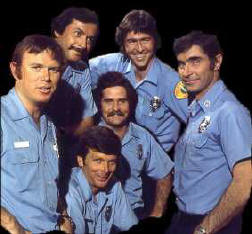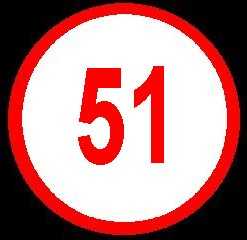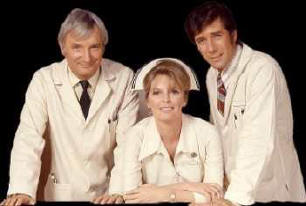Page, founder of the Journal of Emergency Medical Services, died Sept. 4 of cardiac arrest while swimming in a pool in Carlsbad, Calif. He had no known history of heart disease, said a spokeswoman for San Diego-based Jems Communications. Results of an autopsy were pending.
Considered by many to be "the father of modern emergency medical services," Page was a Los Angeles County Fire Department battalion chief when he was assigned to coordinate the countywide implementation of paramedic rescue services in 1971.
The same year, producer-actor Jack Webb hired Page as technical advisor and a writer for the new "Emergency!" television series, which has been credited with introducing modern EMS to America.
Page, however, faced a tremendous amount of resistance as an early advocate of emergency medical services in the fire service, said Gary Ludwig, director of EMS and fire education at Sanford-Brown College in St. Louis.
"You had fire chiefs and firefighters who basically had the attitude, 'We don't do EMS; we just fight fires,' " Ludwig, a former chief paramedic of the St. Louis Fire Department, told The Times last week.
Indeed, Ludwig remembered Page telling him that one fire chief got right in his face and said that it would be over his "dead body" that he would have "sissy nurses riding on my firetrucks."
Ludwig said Page helped turn around thinking about EMS by his pioneering education program and as advisor to "Emergency!" the action-adventure series about L.A. County Fire Department paramedics that "changed the face of EMS on a national level."
"There were only about six paramedic systems nationwide at the time," Ludwig said. "What happened was you had people who watched the show and said, 'Why don't we have something like that in our community?' "
Garry Briese, executive director of the International Assn. of Fire Chiefs, echoed that assessment and added that "Emergency!" "sent a whole generation of kids off wanting to be firefighters and paramedics.
"So, directly and indirectly, he had a tremendous impact on the fire service," Briese said of Page.
Briese also said that when the trade press at the time was not providing the kind of exposure to EMS that Page felt was necessary, he launched the Journal of Emergency Medical Services, considered one of the world's most respected sources of EMS information, in 1979.
By then, Page had added a considerable amount to his resume.
In 1973, he left the L.A. County Fire Department to become chief of EMS for the state of North Carolina, where he implemented a statewide program of emergency medical care and rescue services.
Two years later, he became executive director of Lakes Area Emergency Medical Services in Buffalo, N.Y., and he served as chief administrator of a federally funded project to upgrade and improve emergency services in upstate New York.
From 1976 to 1983, he served as executive director of the ACT - Advanced Coronary Treatment - Foundation and developed programs to upgrade emergency medical services nationwide. He also was the technical support services program manager for the United States Fire Administration, for which he managed a national program of consulting and technical assistance for fire and EMS agencies.
He returned to firefighting in 1984 as a battalion chief in Carlsbad, and two years later was appointed fire chief of Monterey Park, where he had grown up. After leaving that department in 1989, he returned to the full-time position of chairman and chief executive of Jems Communications.
In addition to the Journal of Emergency Medical Services, the company publishes Wildland Firefighter, Homeland First Response and FireRescue magazines. For FireRescue, Page wrote the monthly "Burning Issues" column.
candy crush juego.
In 2000, Chicago-based Fire Chief magazine, the leading information source for fire chiefs and chief officers across North America, recognized Page as one of the 20 people who most shaped the American fire service in the 20th century.
"Jim Page was a visionary when it came to EMS," Janet Wilmoth, editor of Fire Chief magazine, told The Times last week. "But not only was he a visionary, he followed through and changed the emergency medical service in the United States. He had a great impact on it.
"What really impressed me in particular - and I first met him in the mid-'80s - was that in such a male-dominated industry, Jim Page was just a gentleman. And he was a mentor to many, many people."
Born in Alhambra on Aug. 7, 1936, Page began his fire service career with the Monterey Park Fire Department in 1957. He joined the L.A. County Fire Department two years later.
While with the county Fire Department, he received a law degree from Southwestern Law School. A licensed California attorney since 1971, he was a partner in the law firm of Page, Wolfberg and Wirth at the time of his death.
Page wrote seven books, including "The Paramedics" and "Emergency Medical Services for Fire Departments." He wrote more than 400 magazine articles and editorials, delivered more than 750 speeches on fire protection and emergency services and was a consultant for more than 100 cities, counties and fire districts throughout the U.S., Canada, Australia, New Zealand, Japan and Kuwait.
In 1995, he received the first James O. Page EMS Achievement Award from the International Assn. of Fire Chiefs, which became an annual award. A year later, he established and funded an EMS educational foundation at Palomar College near San Diego.
Page, who retired from Jems Communications in 2001, is survived by his wife, Jane; sons Andy and Tom; daughters Debbie Ries and Susan von Beck; his mother, Marion; sister Carolyn; and six grandchildren.
A memorial service will be held at 10 a.m. Thursday at Carlsbad Community Church, at 3175 Harding St.
Instead of flowers, the family requests that donations be made to the County of Los Angeles Fire Museum, James O. Page Memorial fund, P.O. Box 3325, Alhambra, CA 91803.
Read another Jim Page Obit.



